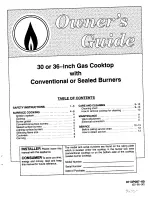
EN
103
Do not use cleaning materials
meant for steel as they may dam-
age the glass.
• If substances with a low melting point
are used in the cookware’s base
or coatings, they can damage the
vitroceramic cooktop. If plastic, tin foil,
sugar or sugary foods have fallen on
the hot vitroceramic cooktop, please
scrape it o
ff
the hot surface as quickly
and as safely as possible. If these
substances melt, they can damage
the vitroceramic cooktop. When you
cook very sugary items like jam, apply
a layer of a suitable protective agent
beforehand if it is possible.
• Dust on the surface must be cleaned
with a wet cloth.
• Any changes in colour to the ceramic
glass will not a
ff
ect the structure or
durability of the ceramic and is not
due to a change in the material.
Colour changes to the ceramic glass
may be for a number of reasons:
1.
Spilt food has not been cleaned o
ff
the
surface.
2.
Using inappropriate utensils on the
hob will damage the surface and may
cause the cracking of the glass..
3.
Using the wrong cleaning materials.
Cleaning the Stainless Steel Parts (if
available)
• Clean the stainless steel parts of your
appliance on a regular basis.
• Wipe the stainless steel parts with a
soft cloth soaked in only water. Then,
dry them thoroughly with a dry cloth.
Do not clean the stainless steel
parts while they are still hot from
cooking.
Do not leave vinegar, co
ff
ee, milk,
salt, water, lemon or tomato juice on
the stainless steel for a long time.
















































